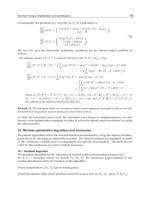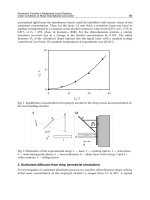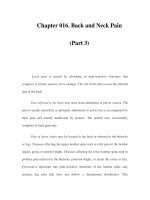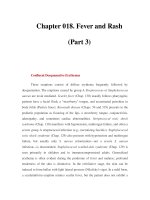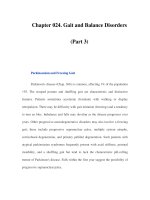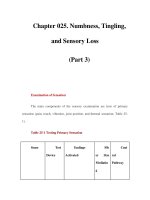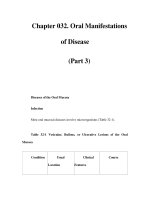Chapter 045. Azotemia and Urinary Abnormalities (Part 3) potx
Bạn đang xem bản rút gọn của tài liệu. Xem và tải ngay bản đầy đủ của tài liệu tại đây (16.89 KB, 5 trang )
Chapter 045. Azotemia and
Urinary Abnormalities
(Part 3)
Approach to the Patient: Azotemia
Once it has been established that GFR is reduced, the physician must
decide if this represents acute or chronic renal injury. The clinical situation,
history, and laboratory data often make this an easy distinction. However, the
laboratory abnormalities characteristic of chronic renal failure, including anemia,
hypocalcemia, and hyperphosphatemia, are often also present in patients
presenting with acute renal failure. Radiographic evidence of renal osteodystrophy
(Chap. 274) would be seen only in chronic renal failure but is a very late finding,
and these patients are usually on dialysis. The urinalysis and renal ultrasound can
occasionally facilitate distinguishing acute from chronic renal failure. An
approach to the evaluation of azotemic patients is shown in Fig. 45-1. Patients
with advanced chronic renal insufficiency often have some proteinuria,
nonconcentrated urine (isosthenuria; isoosmotic with plasma), and small kidneys
on ultrasound, characterized by increased echogenicity and cortical thinning.
Treatment should be directed toward slowing the progression of renal disease and
providing symptomatic relief for edema, acidosis, anemia, and
hyperphosphatemia, as discussed in Chap. 274. Acute renal failure (Chap. 273)
can result from processes affecting renal blood flow (prerenal azotemia), intrinsic
renal diseases (affecting small vessels, glomeruli, or tubules), or postrenal
processes (obstruction to urine flow in ureters, bladder, or urethra) (Chap. 283).
PRERENAL FAILURE
Decreased renal perfusion accounts for 40–80% of acute renal failure and,
if appropriately treated, is readily reversible. The etiologies of prerenal azotemia
include any cause of decreased circulating blood volume (gastrointestinal
hemorrhage, burns, diarrhea, diuretics), volume sequestration (pancreatitis,
peritonitis, rhabdomyolysis), or decreased effective arterial volume (cardiogenic
shock, sepsis). Renal perfusion can also be affected by reductions in cardiac
output from peripheral vasodilatation (sepsis, drugs) or profound renal
vasoconstriction [severe heart failure, hepatorenal syndrome, drugs such as
nonsteroidal anti-inflammatory drugs (NSAIDs)]. True, or "effective," arterial
hypovolemia leads to a fall in mean arterial pressure, which in turn triggers a
series of neural and humoral responses that include activation of the sympathetic
nervous and renin-angiotensin-aldosterone systems and ADH release. GFR is
maintained by prostaglandin-mediated relaxation of afferent arterioles and
angiotensin II–mediated constriction of efferent arterioles. Once the mean arterial
pressure falls below 80 mmHg, there is a steep decline in GFR.
Blockade of prostaglandin production by NSAIDs can result in severe
vasoconstriction and acute renal failure. Angiotensin-converting enzyme (ACE)
inhibitors decrease efferent arteriolar tone and in turn decrease glomerular
capillary perfusion pressure. Patients on NSAIDs and/or ACE inhibitors are most
susceptible to hemodynamically mediated acute renal failure when blood volume
is reduced for any reason. Patients with bilateral renal artery stenosis (or stenosis
in a solitary kidney) are dependent upon efferent arteriolar vasoconstriction for
maintenance of glomerular filtration pressure and are particularly susceptible to
precipitous decline in GFR when given ACE inhibitors.
Prolonged renal hypoperfusion can lead to acute tubular necrosis (ATN; an
intrinsic renal disease discussed below). The urinalysis and urinary electrolytes
can be useful in distinguishing prerenal azotemia from ATN (Table 45-2). The
urine of patients with prerenal azotemia can be predicted from the stimulatory
actions of norepinephrine, angiotensin II, ADH, and low tubule fluid flow rate on
salt and water reabsorption. In prerenal conditions, the tubules are intact leading to
a concentrated urine (>500 mosm), avid Na retention (urine Na concentration < 20
mM/L; fractional excretion of Na < 1%), and U
Cr
/P
Cr
> 40 (Table 45-2). The
prerenal urine sediment is usually normal or has occasional hyaline and granular
casts, while the sediment of ATN is usually filled with cellular debris and dark
(muddy brown) granular casts.
Table 45-2 Laboratory Findings in Acute Renal Failure
Index Prerenal
Azotemia
Oliguric Acute
Renal Failure
BUN/P
Cr
Ratio
>20:1 10–15:1
Urine sodium (U
Na
),
meq/L
<20 >40
Urine osmolality,
mosmol/L H
2
O
>500 <350
Fractional excretion of
sodium
<1% >2%
Urine/plasma creatinine
(U
Cr
/P
Cr
)
>40 <20
Note: BUN, Blood urea nitrogen; P
Cr
, plasma creatinine; U
Na
, urine sodium
concentration; P
Na
, plasma sodium concentration; U
Cr
, urine creatinine
concentration.
